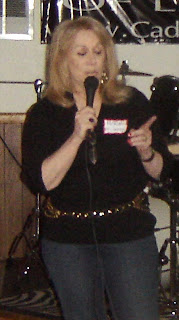 |
| Great turnout at Las Vegas Writers Group meeting Feb. 16 |
The topic was one that often plagues writers at every stage of their career. Who owns the scene? Who is saying what, where and why?
What are the challenges and how can you solve them? Often the solution is very easy if you think outside the box. We discussed the three main points of view used in fiction: first person, third person and third person omniscient. Omniscient is a knows-all, sees-all narrator who even knows what characters are thinking, but the information is not filtered through the narrator's senses. It is simply a telling of whatever he/she sees or hears. Second person is used occasionally so we just touched upon that.
 |
| Reading from my Writers' Tricks of the Trade book |
I believe in the KISS principle: keep it simple, stupid. When you try to cover too many things in a short presentation, the result is generally confusion or worse yet, wandering minds can result in people dozing off during the talk. Ugh. Why try to put everything that's displayed on the buffet table on your plate when you will only eat certain things? That's always my approach when giving talks and writing "how-to" articles.
My sister Phyllice Bradner (co-author of the Silver Sisters Mysteries) and I learned about POV the hard way--with rejection letters for our first novel. After a while we realized that most of the rejections had a common theme: Your writing is polished, but your point of view is all over the place. The exceptions were form letters that began with I can't get sufficiently enthused about your novel... . We studied and learned how to do it the right way. Our first published novel, A Corpse in the Soup---the one with all the rejection notices---was rewritten, published and actually named Best Mystery Audio Book 2007 by USA Book News. To illustrate the transition of "point of view all over the place," to a rewritten passage with a clear point of view crafted in third person, I read an original and edited passage used as an illustration in the P is for Point of View chapter in Writers' Tricks of the Trade: 39 Things You Need to Know About the ABCs of Writing Fiction.
 We continued with an illustration of first person using Chip St. Claire's moving autobiography The Butterfly Garden, Surviving Childhood on the Run with One of America's Most Wanted. It was a moving passage that clearly showed first person was the hands-down choice for this book.
We continued with an illustration of first person using Chip St. Claire's moving autobiography The Butterfly Garden, Surviving Childhood on the Run with One of America's Most Wanted. It was a moving passage that clearly showed first person was the hands-down choice for this book.I want to thank Richard Warren, the organizers, program chairperson Lindsay and the wonderful members of Las Vegas Writers Group for inviting me to be their February speaker. If you are a writer who lives in the area and hasn't checked out this group, do yourself a favor. Visit their MeetUp page and mark your calendar to attend a meeting.
When I write "how-to" articles or books, I write like I speak--in plain understandable language with plenty of examples or illustrations to form images that are easy to grab onto and visualize. My greatest gratification is when readers or people who have heard me speak come up to me afterwards and say that I made a difficult topic easy to understand, or that they enjoyed the energy I pump into my talks. Most of all, I love it when they say I solved a problem for them. That's why I do this. I received lots of help along my journey in this crazy business of writing books and now it's time for me to share and give back.

I will be presenting a series of 4 Webinars during the month of March for SavvyAuthors.com. and the first one is an extended version of What's the Point of Point of View and Why Does It Matter? Visit their website for more information.

KISS. You must have had me in mind. Great post.
ReplyDeleteHah! Happy Sunday. MORGAN
Delete